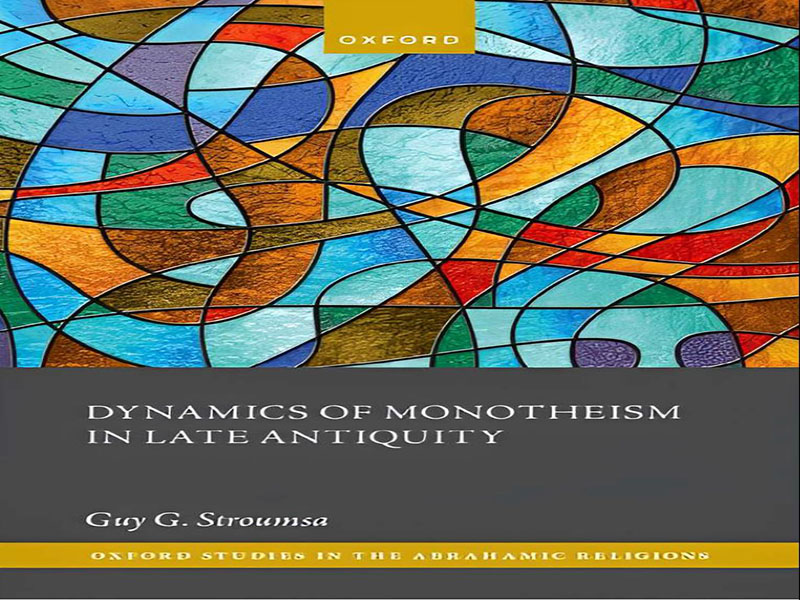- عنوان کتاب: Dynamics of Monotheism in Late Antiquity
- نویسنده: Guy G. Stroumsa
- حوزه: یکتاپرستی
- سال انتشار: 2025
- تعداد صفحه: 162
- زبان اصلی: انگلیسی
- نوع فایل: pdf
- حجم فایل: 2.73 مگابایت
اگرچه ایده توحید مدتهاست که با ما بوده است، اما خود این اصطلاح نسبتاً جدید است. اولین ظهور انگلیسی آن در سال ۱۶۶۰، در کتاب «تبیین راز بزرگ خداپرستی» اثر هنری مور بود؛ این اصطلاح تا قبل از سال ۱۷۵۰ در انگلیسی رواج پیدا نکرد و حتی دیرتر وارد زبانهای آلمانی، فرانسوی و ایتالیایی شد. استفاده از این اصطلاح در دهه آخر قرن نوزدهم – اوج امپراتوری بریتانیا، زمانی که نویسندگان دوره ویکتوریا به «هیاهوی سنتهای شرکآمیز هندی» جذب شدند، به اوج خود رسید. «چرا توحید؟» این سؤال را میتوان از بالادست (چرا یک خدا به جای چند خدا؟) یا از پاییندست (چرا یک خدا به جای هیچ خدا؟) پرسید. طبق یک دیدگاه علمی گسترده، که بهترین نمونه آن دیوید هیوم در کتاب «تاریخ طبیعی دین» (۱۷۵۷) است، تعداد خدایان در تاریخ بشر در یک فرآیند مداوم سادهسازی و عقلانیسازی رو به کاهش بوده است. اگر چنین باشد، پس یک خدا به بیخدایی بسیار نزدیک میشود. در واقع، یوسفوس شهادت میدهد که در قرن اول پیش از میلاد، یهودیان توسط آپولونیوس اهل مولون، بیخدا، یا آتئوئی، نامیده میشدند.3 فرآیند تاریخی سادهسازی را میتوان به عنوان فرآیند عقلانیسازی در نظر گرفت که یادآور «افسونزدایی از جهان» (Entzauberung der Welt) ماکس وبر است. عقلانیسازی به سادهسازی مداوم نظام جهان و از این رو کاهش مداوم تعداد قدرتهای الهی مسئول آن اشاره دارد. در این الگو، تکامل دینی از طریق انقلاب رخ میدهد. در جهان باستان، فرعون اخناتون، پیامبر زرتشت و پادشاه نبونیدوس، هر کدام به روش خود، سعی کردند بر سادهسازی جهان آسمانی اصرار ورزند: تنها یک خدا، خدای حقیقی یا تنها خدای شایسته پرستش بود. با این حال، اگرچه مصرشناسان اغلب انقلاب مذهبی اخناتون را با اصطلاحات توحیدی ارائه میدهند، اما آن را «کیهانپرستی» نیز توصیف کردهاند، در حالی که پرستش سین، خدای ماه، توسط نبونیدوس، مسلماً به هنوتئیسم نزدیکتر بود تا توحید. بعداً در کتاب به این مفاهیم باز خواهیم گشت. توحید در اشکال و رنگهای مختلفی وجود دارد و تقریباً هرگز خالص یا مطلق نیست. مانند همه نظامهای مذهبی، ناپایدار است و دستخوش تغییرات بیپایان و گاهی اوقات دگرگونیهای اساسی میشود. امروزه، وقتی از «ادیان ابراهیمی» صحبت میکنیم، به یهودیت، مسیحیت و اسلام و همچنین ادیان خویشاوند مختلف، مانند ادیان سامری یا احمدیه، اشاره میکنیم. توحید ابراهیمی باستان متأخر یا جهانشمول – مسیحیت و اسلام – یا خاصگرایانه – یهودیت – بود. برای مسیحیان و همچنین برای مسلمانان، حقیقت مذهبی یکسانی باید توسط همه بشریت – همه افراد و همه مردم – به اشتراک گذاشته شود. از سوی دیگر، یهودیان همیشه پارادوکس یک خدای جهانی و یک قوم برگزیده را حفظ کردهاند. در اوایل، خدای اسرائیل با قوم خود، فرزندان حقیقی ابراهیم، که توسط عهد به ملتی کاهن و قومی مقدس تبدیل شده بودند، وارد یک رابطه قراردادی شد. در حالی که خدای ملی آنها به زودی جهانی شد، یهودیان بر حفظ هویت ملی خاص خود اصرار داشتند. در ادبیات علمی، اشاره به «ادیان ابراهیمی» اغلب به طور ضمنی نشان میدهد که این مفهوم قبل از قرن هفتم کاربرد ندارد. با این حال، در واقع، تا اواسط قرن دوم، مسیحیان خود را به عنوان وارثان واقعی ابراهیم – جایگزین یهودیانی که به گفته آنها راه او را رها کرده بودند – قرار دادند. مسیحیان همچنین ادعا کردند که تنها آنها وعدههای کتاب مقدس را که یهودیان نسبت به آنها کور مانده بودند، درک میکنند. به عنوان مثال، این موضوع به وضوح در نوشتههای جاستین شهید بیان شده است. به یک معنا، Auseinandersetzung بین یهودیان و مسیحیان در اواخر دوران باستان، داستان جدال بین آنها در مورد اینکه چه کسانی پسران واقعی ابراهیم هستند، میباشد. بحث بین یهودیان و مسیحیان مستقیماً در متون جدلی یهودی و (عمدتاً) مسیحی ارائه شده و در سایر ژانرهای ادبی (مثلاً اشعار مذهبی یهودی و مسیحی) و همچنین در سنتهای تفسیری شفاهی مانند میدراش در میان یهودیان و در تعدادی از سنتهای مسیحی، اغلب به زبان سریانی، منعکس شده است. حافظه جمعی و مذهبی مسیحی در اینجا با حافظه جمعی یهودی مرتبط است. خود قرآن از اوایل قرن نوزدهم به خوبی شناخته شده است و همانطور که در تحقیقات معاصر بیشتر نشان داده شده است، این سنتهای تفسیری و جدلی را منعکس میکند. اگرچه قرآن پیشینهای شرکآمیز در عربستان نشان میدهد، تحقیقات اخیر شواهدی از حضور چشمگیر یکتاپرستان در شبه جزیره عربستان غربی، از حجاز تا یمن، بسیار فراتر از دسترس جوامع یهودی و مسیحی، یافته است. ماهیت دقیق این توحید که به اواخر قرن چهارم میلادی برمیگردد، ناشناخته است. با این حال، به نظر میرسد که چیزی داشته است که میتوان آن را «ذوق» یهودی نامید.
Although the idea of monotheism has been with us for a very long time, the term itself is a relative newcomer. Its first English appearance was in 1660, in Henry More’s Explanation of the Grand Mystery of Godliness; it did not gain currency in English before 1750, and entered German, French, and Italian even later. The term’s usage peaked during the last decade of the nineteenth century —the heyday of the British Empire, when Victorian writers were drawn to the amboyance of Indian polytheistic traditions. “Why monotheism?” The question can be asked from upstream (why one god rather than many?) or from downstream (why one god rather than none?). According to a widespread scholarly view, best exemplified by David Hume in his Natural History of Religion (1757), the number of gods has been declining in human history, in a steady process of simpli fication and rationalization. If so, then one god gets very close to no god at all. Indeed, Josephus testi fies that in the first century BCE the Jews were called godless, atheoi, by Apollonius of Molon. 3 The historical process of simplification can be seen as one of rationalization, recalling Max Weber’s “disenchantment of the world” (Entzauberung der Welt). Rationalization refers to the continuous simpli fication of the system of the universe, and hence the continuously shrinking number of divine powers in charge of it. In this paradigm, religious evolution takes place through revolution. In the ancient world, the pharaoh Akhnaton, prophet Zarathustra, and king Nabonidus tried, each in his own way, to insist upon a simpli fication of the heavenly world: only one god was the true one, or the only one worthy of worship. However, although Egyptologists often present Akhnaton’s religious revolution in monotheistic terms, it has also been characterized as “cosmotheism,” while the devotion to Sin, the moon god, by Nabonidus, was arguably closer to henotheism than monotheism. We will return to these concepts later in the book. Monotheism comes in many shapes and colors, and it is almost never pure or absolute. Like all religious systems, it is unstable, given to endless ux and sometimes to radical transformation. Today, when we speak of “Abrahamic religions,” we are referring to Judaism, Christianity, and Islam, as well as to various kindred religions, such as those practiced by the Samaritans or the Ahmadis. Late antique Abrahamic monotheism was either universalist—Christianity and Islam—or particularist—Judaism. For Christians as well as for Muslims, the same religious truth is to be shared by all humanity—all individuals and all peoples. Jews, on the other hand, have always maintained the paradox of a universal God and a chosen people. Early on, the God of Israel entered into a contractual relationship with his people, Abraham’s true offspring, who were transformed by the covenant into a priestly nation and a saintly people. While their national God soon became universal, the Jews insisted on preserving their particular national identity. In scholarly literature, references to the “Abrahamic religions” often implicitly suggest that the concept does not apply before the seventh century. In fact, however, by the middle of the second century Christians had positioned themselves as the true inheritors of Abraham—replacing the Jews, who they said had abandoned his path. The Christians also claimed that they alone understood the biblical promises to which the Jews remained blind. This is clearly stated, for instance, in the writings of Justin Martyr. In a sense, the Auseinandersetzung between Jews and Christians throughout late antiquity is the story of the polemics between them regarding who are the true sons of Abraham. The argument between Jews and Christians is presented directly in Jewish and (mainly) Christian polemical texts, and reected in other literary genres (Jewish and Christian liturgical poetry, for instance), as well as in oral exegetical traditions such as Midrash among the Jews, and in a number of Christian traditions, often in Syriac. Christian collective and religious memory is here conated with the Jewish collective memory. The Qur’an itself has been well known since the early nineteenth century, and, as further shown in contemporary research, reects these exegetical and polemical traditions. Although the Qur’an exhibits a polytheistic background in Arabia, recent research has found evidence of a signi ficant monotheist presence in the western Arabian peninsula, from Hedjaz to Yemen, way beyond the reach of Jewish and Christian communities. The precise nature of this monotheism, which has been dated to the late fourth century, is unknown. However, it appears to have had what one could call a Jewish “avor.” Hence, when we speak, as is becoming increasingly fashionable, of the Qur’an as a “late antique text,” we ought to remember that it is a very speci fic kind of late antiquity that is referred to here: that of Abrahamic religions, not that of Hellenic paideia. Both Gerald Hawting and Patricia Crone have argued that the mushrikū n of the Qur’an (lit. “those who associate” [another divine figure with the One God]) were monotheists, as has long been claimed. Indeed, shirk seems to lie at the very heart of monotheism.
این کتاب را میتوانید از لینک زیر بصورت رایگان دانلود کنید:
Download: Dynamics of Monotheism in Late Antiquity



































نظرات کاربران